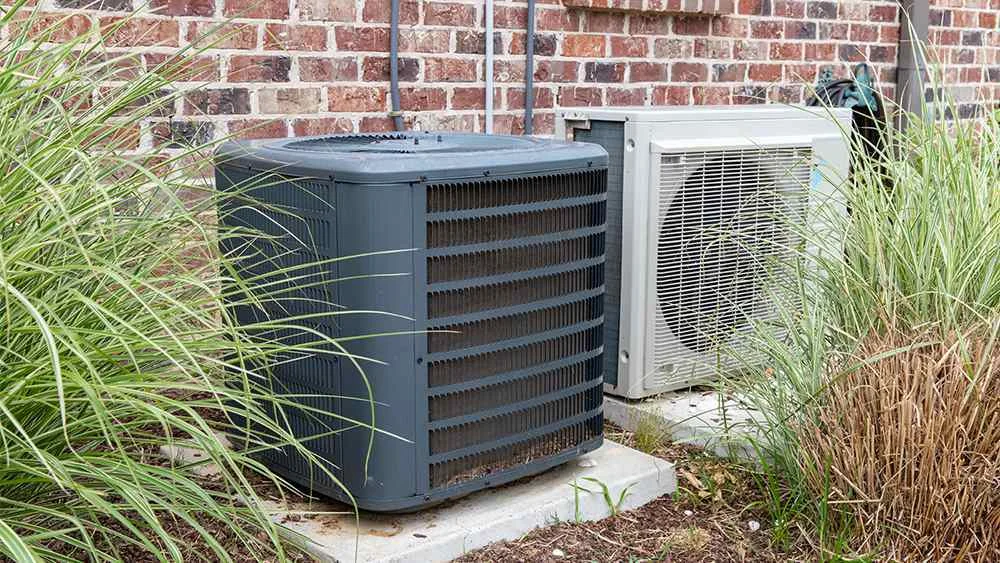
Key Takeaways
- Dirty filters, clogged coils, and incorrect thermostat settings are behind most common heat pump issues.
- Correct sizing and setup matter; an improperly sized or poorly installed unit can’t heat or cool efficiently.
- Issues like refrigerant leaks and electrical failure need professional help.
Heat pumps are becoming an increasingly popular alternative to conventional heating appliances because they can heat and cool efficiently, resulting in low energy usage. For instance, an air-source heat pump, which transfers heat between the air outside your home and the air inside, can provide 1.5 to 3 times more heat energy to a home than the electrical energy it consumes. In addition, their energy and cost efficiency make them a desirable purchase for homeowners.
While heat pumps are efficient and convenient, they are subject to wear and tear like any other machine.
If you’re wondering how to troubleshoot a heat pump, don’t worry. This article contains helpful tips that will get your unit up and running quickly.
What Is a Heat Pump and How Does It Work?
First, it is important to understand how a heat pump works to learn how to troubleshoot it.
All heat pumps work on the same basic principle. Rather than burning fuel to create heat, they simply move heat from one place to another.
There are two main types of heat pumps:
Air-Source Heat Pumps
Air-source heat pumps transfer heat between the air outside your home and the air inside.
There are two further types: ducted vs. ductless air-source heat pumps.
Ductless heat pumps are minimally invasive. Only a tiny hole in the wall is required to connect the indoor and outdoor units. Usually, there is one unit for each room. On the other hand, ducted heat pumps have one powerful central unit that heats or cools your entire home through ducts.
Ground-Source Heat Pumps
Ground-source heat pumps, also known as geothermal systems, extract heat from the ground and transfer it indoors.
Both air-source and ground-source heat pumps work on the same basic principle.
In heating mode, a heat pump absorbs heat energy from the outside air and transfers it to the inside air. In cooling mode, a heat pump functions similarly to an air conditioner. It absorbs heat from the indoor unit and releases it through the outdoor unit.
11 Common Heat Pump Problems – Heat Pump Troubleshooting
With time, you might see a decrease in your heat pump’s efficiency or working. Diagnosing heat pump problems can be challenging since they could be caused by plenty of reasons. Here are the 11 most common issues and some residential heat pump troubleshooting tips.
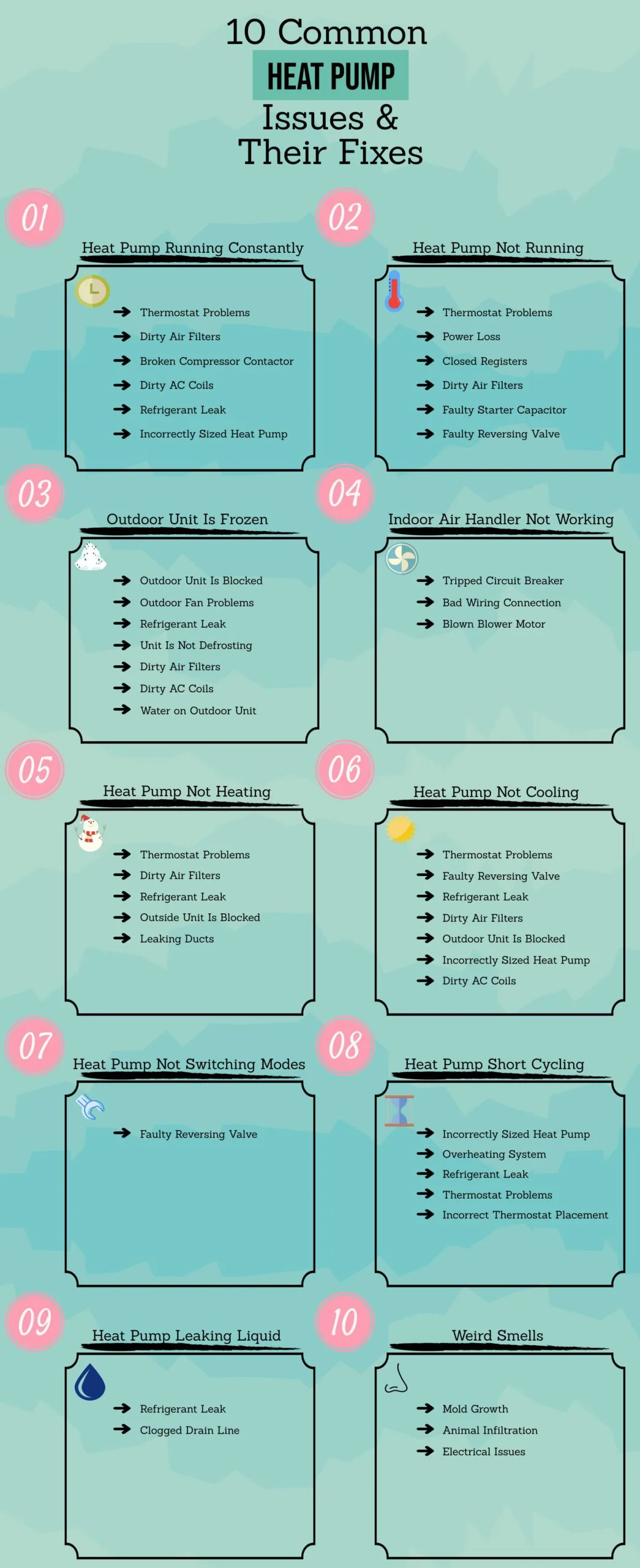
1. Heat Pump Running Constantly
Are you tired of sky-high energy bills and want to reduce your AC costs? If your heat pump is constantly running at full blast, it may be a significant factor behind high energy costs.
Your heat pump may be constantly running for a few reasons. Fortunately, most of them are easily fixable.
- Incorrect Thermostat Settings
If you set your thermostat at a temperature that is either too high or too low, your heat pump would have to run constantly to maintain the set temperature.
Equip your HVAC system with smart features and achieve the perfect balance between comfort & savings.
Learn more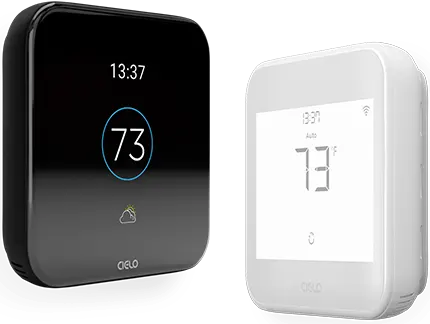
In summer, the ideal thermostat setting is 78F to stay cool while avoiding high electricity bills. Set your thermostat to 78F for a few hours. Then, if you feel uncomfortable, decrease the temperature by a couple of degrees until you find the most comfortable temperature.
In winter, set your thermostat anywhere between 68F to 72F. If you are having trouble adjusting to this temperature, add extra layers of clothing. That’s not enough, either. Set the temperature a few degrees higher and lower it to 72F gradually. If you are comfortable at 72F, try lowering the temperature a few degrees further.
Another reason could be that your thermostat needs to be correctly calibrated. Here’s a handy guide on how to calibrate your thermostat.
Tip: Manually changing the thermostat settings now and then can get on your nerves. Invest in a smart thermostat to automate your home climate and easily make all the adjustments using the app.
- Dirty Air Filters
For a heat pump to run efficiently, it needs a steady supply of fresh, clean air. If your heat pump air filters are dirty and clogged, less air will pass through, and as a result, your heat pump will need to run constantly to maintain your set temperature.
Replacing or cleaning the air filters will solve this problem. On average, you should clean your air filters every two weeks and replace them every three to four months.
A visual inspection is more than enough to determine if your air filters are dirty. Hold them up against a light source, and if you can see through them unobstructed, you are good to go. If not, you can wash your air filters with soapy water and let them air dry before putting them back.
Read our detailed guide on cleaning an air conditioner.
- Broken Compressor Contactor
A contactor is a small device that controls the flow of electricity to your heat pump’s components. If your compressor contactor breaks, your heat pump could run constantly. You’ll need a professional to diagnose whether you have a broken compressor contactor and if you need to replace it or not.
- Dirty Coils
If you haven’t had your heat pump serviced for a while, there may be grime on the coils, which prevents them from working correctly. Also, since heat transfer occurs through the coils, they cannot function properly if dust, ice, or dirt are on them. Therefore, on average, you should clean your AC coils every two months.
- Refrigerant Leak
A refrigerant leak also forces your heat pump to run constantly. A refrigerant is a liquid inside the coils through which heat transfer occurs between the indoor and outdoor air. If the refrigerant charge is low, adequate heat transfer cannot happen. As a result, your heat pump’s heating or cooling capacity decreases, so the heat pump must constantly run to maintain the temperature.
If you suspect a refrigerant leak, contact an HVAC professional to diagnose the leak and fix it. You should never attempt to recharge the refrigerant or fix a refrigerant leak yourself.
- Incorrectly Sized Heat Pump
If you have eliminated all other possibilities and your heat pump is still running constantly, it may be due to the wrong size. For example, if your heat pump is too small for your living space, it will have to run constantly to maintain the set temperature.
Check our air conditioner sizing guide to see whether your unit is compatible with your home’s needs.
2. Heat Pump Is Not Running
If you discover that your AC simply won’t turn on or has stopped running, there are a few easy heat pump troubleshooting steps you can follow. However, in some cases, you will have to contact a professional to diagnose the problem.
Here are some of the most common reasons your heat pump won’t turn on:
- Thermostat Problems
A thermostat tells your heat pump what temperature to maintain. If it loses power for some reason, it cannot communicate with the heat pump about what to do, and your heat pump will not turn on.
If your thermostat screen is blank, it indicates that it does not have power. Replace the batteries or, for hardwired units, check your home’s electrical panel. The circuit breaker may have tripped, or you may have a blown fuse. You can identify a blown fuse and replace it yourself. However, make sure that you disconnect the electrical power before removing the fuse.
Related: Thermostat Not Working Properly? 14 Easy Fixes
- Power Loss
Your heat pump’s indoor and outdoor units have separate power switches. First, check the power switch on or near the indoor unit and confirm it is set to ON. Next, check the power switch on or near the outdoor unit and see if it is set to ON. Finally, check your home’s electrical panel and see if you have a tripped circuit breaker or a blown fuse.
- Closed Registers
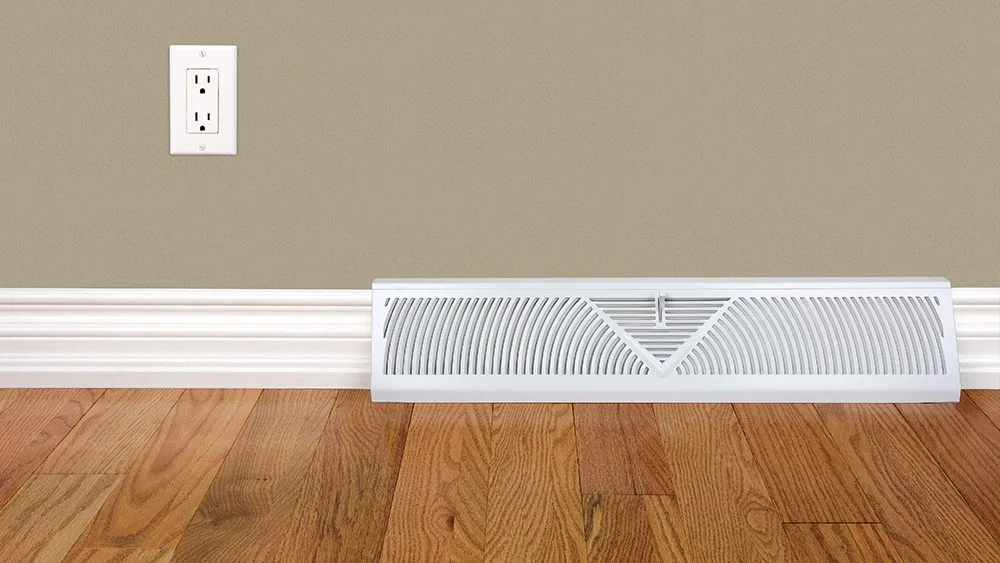
If you have a ducted heat pump, check if all the registers are open and unobstructed. If you have obstructed the registers by any furniture or if they are clogged with dirt, it may feel as if your heat pump is not running because you are not receiving any air.
- Dirty Air Filters
If your air filters are filthy and clogged, your unit needs to receive more fresh air. As a result, your heat pump has to work overtime to maintain your desired temperature. The increased load can cause it to overheat and shut down.
Remove your air filters and hold them up against a light source. If you can see through them unobstructed, your air filters are clean. If not, wash your air filters with soapy water and let them air dry.
- Faulty Starter Capacitor
The starter capacitor delivers power to the motor driving the heat pump, providing a burst of energy to turn on the unit. If your starter capacitor breaks, your heat pump won’t turn on.
If you detect a faint clicking noise coming from your heat pump when you try to turn it on, that is a sign that your starter capacitor is faulty. You should never attempt to replace a starter capacitor on your own. Even with the power disconnected, it holds a lot of electric charges and can electrocute you.
- Faulty Reversing Valve
The reversing valve allows your heat pump to cool and heat your home. If your reversing valve is faulty, your heat pump may turn on in heating mode but not cooling mode and vice versa. If your heat pump only turns on for one of the modes, contact an HVAC professional to look at the reversing valve.
3. Outdoor Unit Is Frozen
In winter, a light layer of ice can cover your outdoor unit. Consequently, your heat pump has to go into defrost mode to remove that layer of ice. However, a thick layer of ice impedes heat transfer between the outside coil and outside air. As a result, your heat pump is unable to heat your house properly. If the ice is left on the external unit for too long, it could permanently damage your heat pump.
Related: Air Conditioner Freezing Up? Explore the Causes of AC Freezing and What You Can Do
- Outdoor Unit Is Blocked
If piles of snow accumulate around your outdoor unit in winter, it can prevent the ice from melting. Unfortunately, the reduced airflow can cause even more ice buildup. Regularly clean snow from the area around the outdoor unit. To defrost the ice, never chip it away with a sharp tool. You can easily damage the coils. Instead, spray water from a hose to gradually melt the ice.
- Outdoor Fan Problems
In your outdoor unit, the fan blows air over the coil with refrigerant in it, which is essential to the heat transfer process required for heating or cooling your house. If your outdoor fan is defective, there is little to no airflow, which can cause your outdoor unit to freeze over. In this case, contact a professional to look at your outdoor fan motor.
- Low Refrigerant
Since refrigerant plays an important role in heat transfer, there can no longer be adequate heat transfer if there is a refrigerant leak. Eventually, your heat pump will not produce enough heat to melt the ice on the outside unit. If you suspect a refrigerant leak, never attempt to fix it yourself. Instead, always leave it to a professional.
- Unit Is Not Defrosting
In winter, your heat pump periodically switches to air conditioning mode to defrost the ice on the outside unit. Air conditioning mode heats the outdoor unit so that any frost or ice melts. If the unit is not defrosting, ice can build up quickly.
The reversing valve is responsible for switching the heat pump from heat mode to air conditioning mode. If the reversing valve breaks, the unit does not defrost. Therefore, you should contact a seasoned HVAC professional to take a look at the reversing valve.
Your unit could also have a malfunctioning defrost timer. The defrost mode on your heat pump is designed to turn on periodically. If your defrost timer is defective, your unit is not defrosting as frequently as it should, resulting in ice buildup. An HVAC professional can determine whether the defrost timer is working correctly.
- Clogged Filters
Dirty air filters impede airflow. If there isn’t enough air circulating the coils, they become too cold and freeze. Once the coils freeze, they cannot heat or cool properly, causing a layer of ice to build upon the outside unit.
- Dirty Coils
If you have filthy coils with grease or grime on them, effective heat transfer between the coils and the outside air cannot occur. When the coils cannot lose heat to the air, the refrigerant inside them becomes too cold, leading to a layer of ice forming on the coils. As a result, your heat pump can neither heat nor cool properly. It also leads to it not being able to defrost the outside unit efficiently. Thus, the icing upon the external unit worsens.
- Water on Outdoor Unit
If water constantly drips on your outdoor unit in winter, it can freeze and form a layer of ice. First, defrost the outside unit by turning on the defrost mode or spraying water from a hose. Then, locate the water source, such as a leaking gutter, and fix it.
4. Indoor Air Handler Not Working
An air handler works in conjunction with your heat pump to distribute air inside your home. If your outdoor unit is running, but you don’t feel any air coming from the registers, your indoor air handler may not be running.
Here’s why this is happening:
- Tripped Circuit Breaker
Your indoor and outdoor units have separate electrical connections. Check the circuit breaker for your indoor unit and see if it has tripped. Also, keep an eye out for any blown fuses.
If your air conditioner’s circuit breaker keeps tripping, then check this article for ten possible causes.
- Bad Wiring Connection
You could also have loose or frayed wires that are preventing power from reaching the indoor air handler.
- Blown Blower Motor
The worst-case scenario is that you have a blown blower motor. The blower motor is responsible for circulating air throughout your house. A blown blower motor means the heat pump cannot distribute air throughout your home. Unfortunately, you cannot replace a blown blower motor on your own. Instead, you must contact an HVAC professional to do the job for you.
5. Heat Pump Not Heating
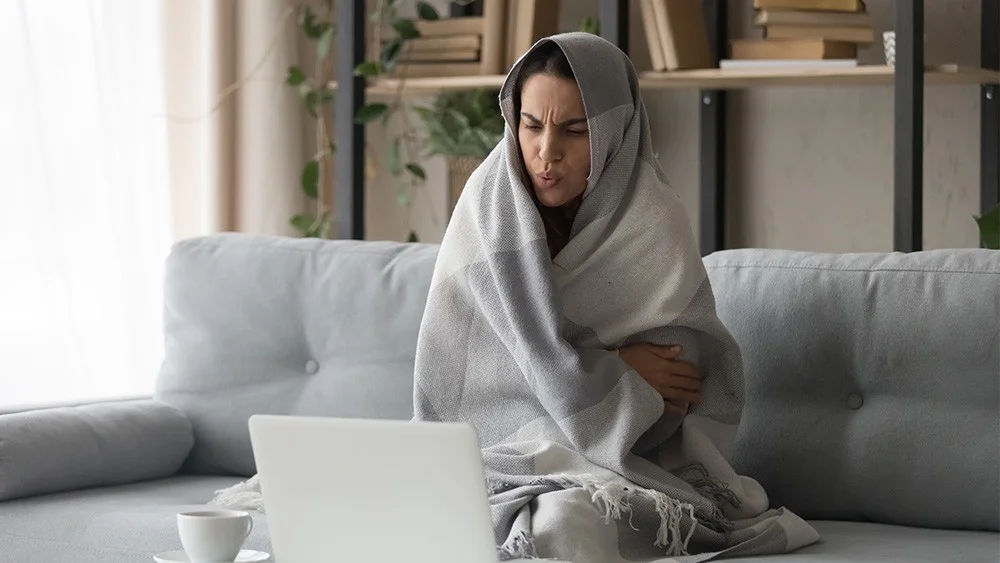
Most people expect their homes to be cozy in winter. That’s likely why you installed a heat pump in the first place. So, it can be uncomfortable, to say the least, if your heat pump stops heating.
Here are some reasons your heat pump is not heating and what you can do to fix it:
- Incorrect Thermostat Settings
Double-check if you’ve set your thermostat to cooling mode. If that is not the case, check if your fan is running continuously. If your fan is running continuously, the system is not actively heating. After that, set the system to heat mode and the fan to auto.
- Incorrectly Calibrated Thermostat
Your thermostat could simply be reading the wrong temperature, leading to issues with heating. Firstly, have a look at your thermostat’s manual to see if there are any instructions on recalibrating it. If not, you can have it replaced or recalibrated by a professional.
- Dirty Air Filters
If your air filters haven’t been cleaned or replaced for a long time, dirt or debris could have clogged them. In case they are clogged, your unit does not receive adequate airflow, which causes it to stop heating. Simply wash your filters with soapy water or replace them to fix this problem.
- Low Refrigerant
If there is a refrigerant leak, adequate heat transfer cannot happen, and your heat pump cannot warm your home.
- Outside Unit Is Blocked
Since your heat pump operates through heat transfer, it cannot pull air from the outside to heat your home if snow or debris has blocked the outside unit. Go outside and clean any debris around your outdoor unit.
- Leaking Ducts
For a central heat pump, if you have sky-high energy bills but less usage to justify it, you could have a duct leak. You can check any exposed ductwork for leaks by holding your hand over connection points. Unfortunately, most of your ductwork is hidden, so you will have to contact an HVAC professional to diagnose any leak deep inside.
6. Heat Pump Not Cooling
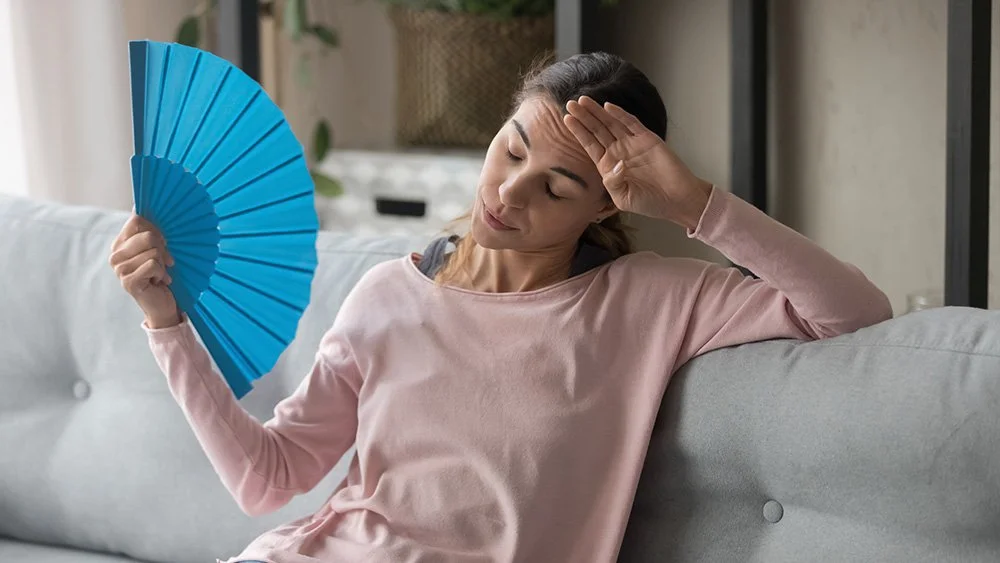
Has your heat pump failed in the middle of a heatwave? Don’t panic! Instead, read these possible reasons why your unit is not cooling in summer, along with what to do.
- Thermostat Problems
Ensure you’ve set your thermostat to cool mode. If the settings are fine, you could have an incorrectly calibrated thermostat.
- Faulty Reversing Valve
If your heat pump works in heating mode but not cooling mode, you could have a faulty reversing valve. Unfortunately, the reversing valve can only be repaired or replaced by a professional.
- Low Refrigerant
If your refrigerant levels are too low, your heat pump won’t cool or heat effectively. Contact a professional to detect any leak and fix it. Be mindful that your HVAC technician does not just top up the refrigerant without fixing the leak.
- Dirty Air Filters
Dirty air filters block airflow to your heat pump, preventing it from drawing enough air from the inside to cool effectively. Regularly clean and replace your air filters.
- Outdoor Unit Is Blocked
If your outdoor unit is covered in debris or blocked by branches or foliage, it cannot effectively expel hot air outside. As a result, its cooling ability decreases. Regularly clean the area around your outdoor unit to prevent blockage.
- Dirty Coils
If your coils are dirty, heat transfer between the refrigerant in them and the air cannot occur. Check for dirt or frost on your coils. Then, clean your heat pump coils. If you see any ice buildup on the coils, allow it to melt. Never try to physically remove the ice, as you can damage the delicate coil fins.
- Incorrectly Sized Unit
If your heat pump is too small, it won’t be able to cool your entire house effectively. A certified HVAC technician can perform a sizing assessment to determine whether your heat pump is the correct size.
7. Heat Pump Doesn’t Switch from Heat to Cool or Vice Versa
If you’re having trouble switching from heat mode to cool mode and vice versa, the reversing valve might be the issue.
- Faulty Reverse Valve
The reversing valve is responsible for switching the heat pump from one mode to another. It reverses the refrigerant flow and allows your heat pump to both heat and cool your home. If your heat pump does not switch from one mode to the other or works fine in one mode but not the other, there is a problem with the reversing valve.
Contact an HVAC professional to inspect your reversing valve and fix any issues.
8. Heat Pump Is Short Cycling
Short cycling is when your heat pump repeatedly turns off soon after it turns on. Short cycling has several causes:
- Improperly Sized Unit
If your unit is too large for your home, it will cool or heat your house too quickly. Once it achieves the desired temperature, it will shut down. Contact an HVAC technician to perform load calculations to check whether your heat pump is appropriate for your house.
- Overheating System
If you have dirty air filters, they can restrict airflow and cause your system to overheat. As a defensive mechanism, your heat pump shuts down.
- Refrigerant Leaks
If there is a refrigerant leak, your heat pump may not have enough refrigerant to complete an entire cycle. Only an HVAC professional can diagnose and fix a refrigerant leak.
- Incorrectly Calibrated Thermostat
If your thermostat generates an incorrect reading, your heat pump will have to keep turning on and off to achieve the desired temperature. First, ensure your thermostat is correctly calibrated. If not, you can recalibrate it or replace it.
Another reason can be wrong thermostat placement. For example, if you have put it in direct sunlight, it will detect a higher temperature. As a result, your heat pump will shut down early even though it has not achieved the desired temperature. Similarly, if you place your thermostat near the ducts, the temperature it detects does not indicate the actual temperature inside your house.
9. Unit Is Leaking Liquid
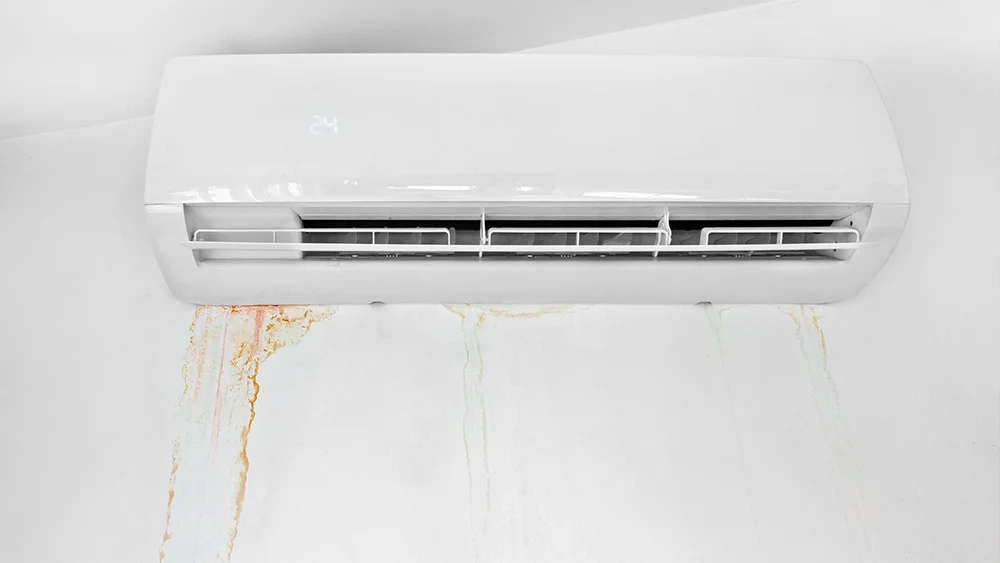
If you notice mold growing on the walls near your heat pump, there may be a leak. Never ignore a heat pump leaking liquid. Apart from causing decay, stagnant water inside your heat pump can also cause electrical damage.
Here are some of the main reasons your AC could be leaking liquid:
- Refrigerant Leak
If your refrigerant leaks, ice can build up on the evaporator coils, hampering the efficiency of your heat pump. In addition, when you turn off your heat pump, this ice melts, causing it to leak water.
- Drain Line Is Clogged
When your heat pump is in cooling mode, it draws in humid air from your home to cool. This process results in condensation. The condensate travels to the condensate pan and is then drained through the drain line. If your condensate pan has any cracks, water can leak through it. Similarly, if your drain line is clogged, it can also lead to water overflowing. If you suspect your drain line is clogged, you can unclog it yourself or contact a professional.
10. Weird Smells
Your sense of smell is one of the best tools for determining whether anything is wrong and requires heat pump troubleshooting.
Here are some of the main reasons your heat pump smells suspicious:
- Mold Growth
If you smell a musty odor, chances are there is mold growing inside your heat pump or on the surrounding walls. Mold in air ducts can also adversely affect your health, so if you suspect mold, turn off the heat pump so no mold spores can circulate inside your home. You can clean the mold yourself if the extent of the problem is not too severe. If there is significant mold, you will either need to contact a professional for deep cleaning or replace the unit.
- Animal Infiltration
If your heat pump smells like it is rotting, an animal may have crawled in and died. Firstly, remove the cover. See if you can remove the carcass yourself. If you are having difficulty, you can always contact an HVAC professional for help.
- Electrical Issues
If your heat pump smells burning, there may be a severe electrical issue on the inside, such as a damaged wire or failing motor. Never dismiss a burning smell. Turn off the circuit breaker immediately and contact an HVAC professional to find the cause of the smell.
11. Heat Pump Blowing Cold Air in Heat Mode
Your heat pump may be blowing cold air due to several possible culprits, from clogged filters to incorrect thermostat settings.
- Lack of Maintenance
If heat pump maintenance is overlooked, it can affect its performance. This is why regular HVAC tune-ups are highly important.
Clean your filters every two weeks and change them every three to four months. You should also clean the dust and debris on your coils every two months.
Also, check the outdoor unit and remove any dust collected on it. Finally, the nearby vegetation should be trimmed as leaves can get stuck inside the system and damage the internal parts.
- Wrong Thermostat Settings
You may have accidentally set your thermostat to cool mode or your fan to “on” instead of “auto”. If the fan is on, the heat pump will continuously blow out air, regardless of whether it’s heated or not.
Check your thermostat and switch the settings to “auto” to fix this issue.
- Heat Pump Is in Defrost Mode
In the defrost mode, your heat pump switches to cool mode and stops delivering hot air. Instead, it dissipates the heat outwards to help melt the ice on outdoor coils.
This is a completely normal process in extreme cold, and there is nothing to worry about. Once the ice has thawed, the defrost cycle will stop, and your heat pump will start working as usual.
- Malfunctioning Reversing Valve
The main function of a reversing valve is to reverse the flow of refrigerant in your heat pump, which means switching from cool to heat and vice versa. If the valve is damaged or has developed a problem, your heat pump may have trouble switching the mode.
The Bottom Line
A heat pump is a versatile HVAC system with numerous advantages. However, like all electrical appliances, it is prone to occasional problems. With these handy heat pump troubleshooting tips, you are sure to be prepared whenever you run into any issues with your unit and keep your home comfortable all year long.
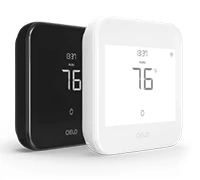

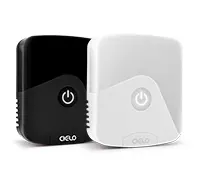
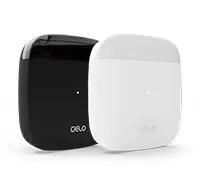

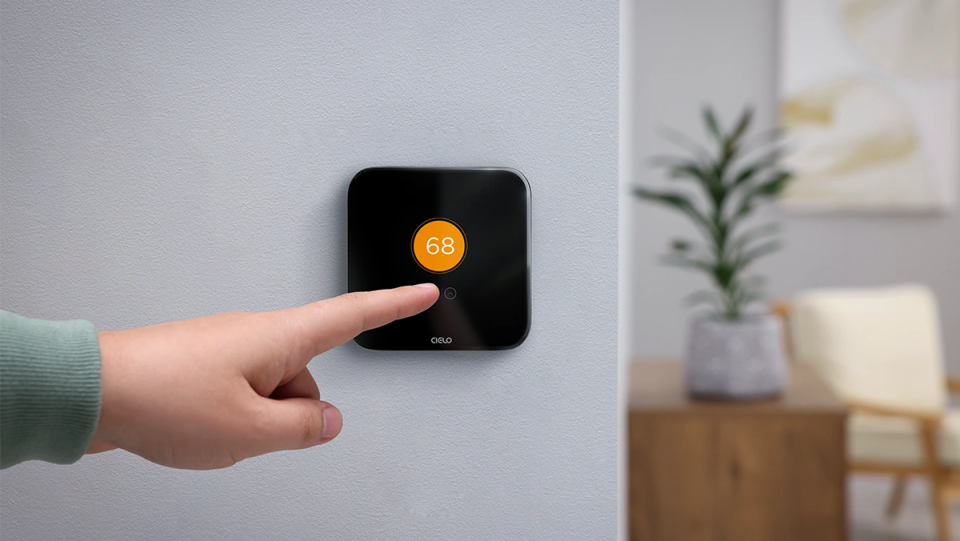
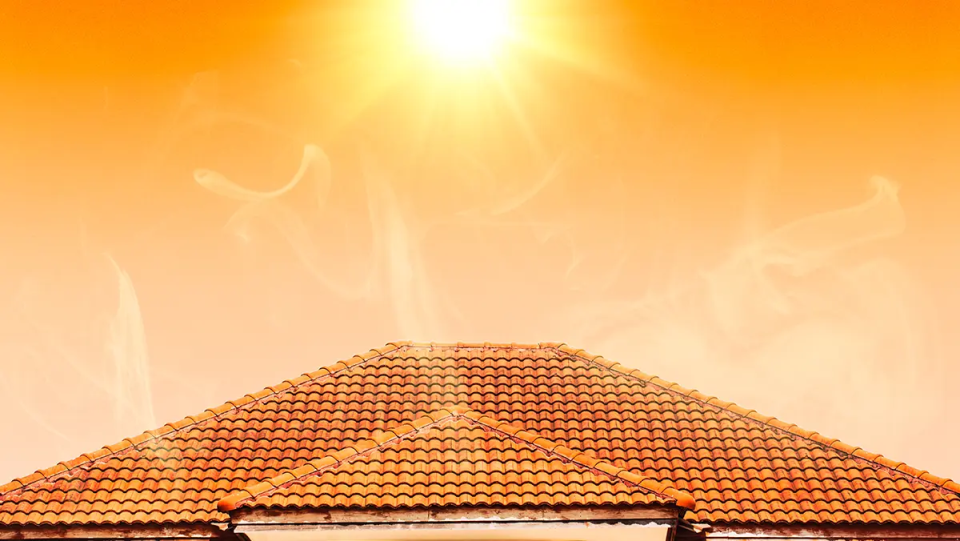
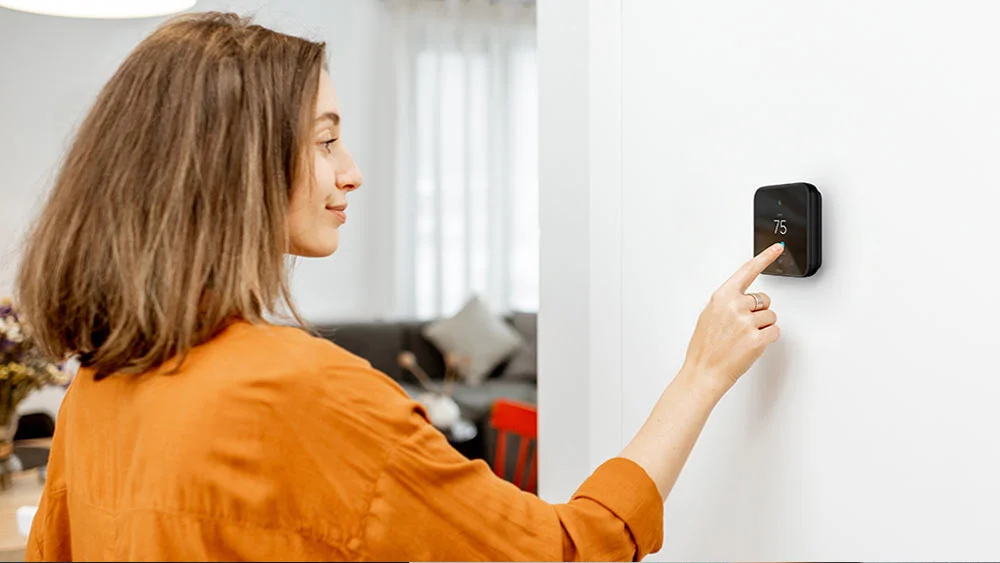
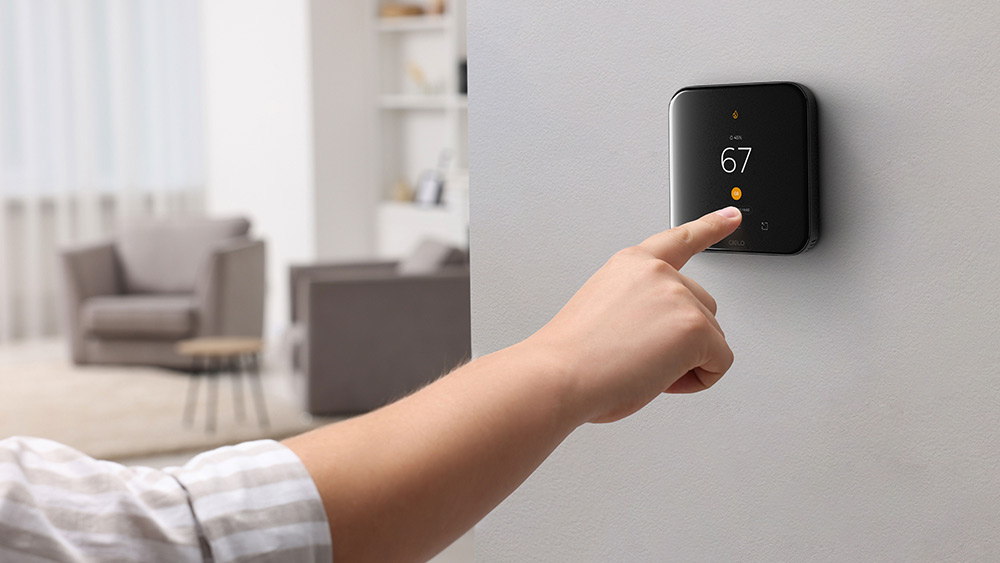
36 Comments. Leave new
My heat pump has given me issues since I purchased my home about 2 years ago. The temperatures are not consistent throughout the home and the heating company keeps doing bandaid fixes to mitigate the underlying problem. I would like to get to the root of the issue.
My ashp for it to run at 21 it has to be set at 15. as the outside temp drops, the outside sensor kicks in and the temp raises to 24 deg, unbearable. Any solutions.
Thank you! after trying several things, i looked on your site and solved my issue by simply changing batteries in the ‘remote’ thermostat: heatpump now works fine. thanks again!
Installed new heat pump ( mini split) Wabban brand. Will run maybe a day, maybe up to 5 days. If the temp. is set at 70 it will maintain the no problem but then it will stop working. The power symbol is on, the temp. that it is set for is showing but the compressor will not run. The last time, the temp was set to 70, room temp was down to 67. To get it to start I slowly brought the temp up to 74 before it started again.
Check your thermostat and make sure it’s calibrated correctly. Check our detailed guide on thermostat calibration – https://cielowigle.com/blog/how-to-calibrate-a-thermostat/
Another reason why you are having this issue could be related to heat pump sizing. If your unit is larger than required, it will heat up your home too quickly, and the compressor will shut down.
My unit doesn’t shut off very often; it takes two hours in the morning to get from 62 to 68 degrees.
The air is very warm during this time, but keeps on running most of the day with cool air. Is this normal? At what temp. does Aux. come on? We have had temps around 30 degrees at night. Thanks.
If your heat pump is blowing cold air, it could be in defrost mode, or you may have clogged air filters preventing warm air from circulating properly in your home. A dirty outdoor unit or incorrect thermostat setting can also result in cool air during winter.
When the outdoor temperature is in the range of 35-40 F, and your home temperature falls below your set point, the auxiliary heating system kicks in. The aux heat will turn off when your home achieves the set temperature.
What will cause a very dusty house with a heat pump. What should we clean? Have cleaned and changed filters still so much dust.
What suggestions do you have when the heating elements do not come on in situations when the outdoor temperature dips below 0 degrees F. Trying to understand if it’s a control logic board issue or if the back-up heating elements are failing. Thanks, Freezing.
I had two technicians come here yesterday and they said it’s working fine. They checked the temperature and it wS heating to around 103.3. The thermometer was set at 72 and the air in the house heated to 72. They told me to shut off the thermostat for ten minutes and let it defrost and turn it back on. They couldn’t find anything wrong after I had turned the system off for 8 hours.
My heat pump, a GENERALLUX STAR 18,000 won,t cut out after reaching the set temperature , just keeps on heating even after dropping the setting to a much lower number. I have to turn it off.
can you smell a refrigerant leak, my heat pump was working fine, then i smelled something burning (like burning wire), now the air coming out is just lukewarm and it takes a long time to heat my home
The burning smell can be due to some electrical issue inside the unit, such as a damaged wire or failing motor. Do not run your unit in this condition. Turn it off immediately and contact an HVAC professional.
Where can I locate a carrier repair person near me?
Our York model DHMF12NWM42Q1A is discharging small black particles, like soot. Any suggestions as to what is causing that?
Black particles from an AC unit are mostly mold spores. Check the inside of your system, specifically air filters and AC coils to check for mold growth. Use an antibacterial dish soap mixed with warm water and spray it on areas you see mold growing. Then use a brush to clean off those areas. Also, call an expert as soon as you can to find out if the mold is growing inside your system or somewhere else in your home as it can have adverse health impacts.
My remote thermostat will not communicate with the wall mounted heat pump??
When I switch from heat to cooling, I have to “flip the breaker switch” on the inside unit before it will cool the house. There is no issue switching from cool to heat.
Heat pump fan kicks on but compressor won’t kick on in cooling mode in heating mode only indoor air handler will come on and nothing from the outdoor heat pump any ideas why?
Hi Jay, maybe there’s an issue with your heat pump reversing valve. If you have a faulty valve, your heat pump will turn on in heating mode but not cooling mode and vice versa. Other common causes of your heat pump not cooling include low refrigerant levels, dirty air filters or coils, or a faulty thermostat. Also, check your outdoor unit for blockage as leaves and debris can get stuck in the system and prevent it from functioning properly.
My compressor fan turns on when the system is set to heat, but the fan does not work in cool mode. Is this a reversing valve problem? Can anything be done in the short term as a temporary fix? Thank you
Hi Mark, it looks like your heat pump has trouble switching modes. It’s likely that reversing valve is stuck or has malfunctioned. Please get in touch with your HVAC technician and have it checked.
I came home to my heat pump making a humming sound with the smell of something burning. The temperature in the house had dropped. What could be the problem?
Hi Susan, a burning smell indicates an electrical issue on the inside, such as a damaged wire or failing motor. Turn off your unit immediately and call an HVAC professional to find the exact issue.
Hello everyone,
I have a brand new Lennox heat pump were installed a couple of years ago. Also new wireless thermostat were installed to function with my existed electrical Furnace at the same time. Since the beginning , kicking in(Start) the heat pump was a problem. Unless I reset the whole system by cutting the power for 30 min, it wont kick in even the outside temperature is 1 or even 6 deg Celsius. BUT, after reset the heat pump starts for a while, it stops when reach the thermostat temp but the fan keeps going and then most of the time the heat pump will not restart again. Appreciate your kind help in advance.
Hi, please contact an HVAC professional to find out the exact issue.
My heat pump heater is warming up the house then blowing cold air before it turns off. However it blows cold air really hard and cools the house so that as soon as it turns off a couple minutes later it has to heat it back up again and the cycle repeats. I was told it has to go into a cool down before shutting off. But it seem counter productive to have it cool the whole house so that it has to turn back on. I do have the heat and air conditioning set 10 degrees apart and the heat is on not auto.
Maybe your heat pump is going into defrost mode. In defrost cycle, the heat pump switches to cool mode to melt the ice on outdoor coils. Refer to our article on defrost cycle for more details: https://www.cielowigle.com/blog/heat-pump-defrost-cycle/
If you think your heat pump is not going into defrost mode, have a professional thoroughly inspect your unit to find out the exact issue.
My window type heat pump started to suddenly use excessive power KWH by a factor of 10 during cold weather. What might cause this?
Dirty air filters, lack of maintenance, and low refrigerant levels can cause this issue. Operating your unit in an extremely cold environment is another factor. Most heat pumps work best when the outside temperature is above 40F. Temperature below 40F results in decreased efficiency.
Good read thanks. Our heat pump frequently groans almost like a cow mooing. I think when it’s cycling off. Somebody said it may be the defrost cycle but I don’t know. Any thoughts?
Hi Maurice, when a heat pump enters defrost mode, it switches from heat to cool mode using a reverse valve. What you’re hearing could be the reversing valve changing position. A loud whoosh sound can be heard during this stage. Another reason can be related to compressor noise. In defrost mode, the outdoor fan stops running, and you start hearing the compressor noise. Normally, the compressor noise is disguised by the outdoor fan.
You can check other signs to see whether your heat pump is going into defrost mode or not. Refer to our blog on heat pump defrost cycle for more details: https://www.cielowigle.com/blog/heat-pump-defrost-cycle/
My condo came with an old heat pump. It doesn’t have a thermostat you can set and forget. If you want heat or cold you have to go and turn on the unit at the unit and turn it off when you want it off.
Hi Anne,
If your condo has a mini-split, portable, or window heat pump, then you can connect it with Cielo Breez smart AC controller and control it through your phone from anywhere, anytime!
Learn more about our products here: https://www.cielowigle.com/products/
My pump only kick in after 30 min power cut from system (Reset). As soo as I turn it off, I need to rest again
New installation and the fan comes on in heating mode but the compressor never starts.
I don’t think aux. heat comes on either.
Have 240V at the outdoor unit. Have “00” on display.